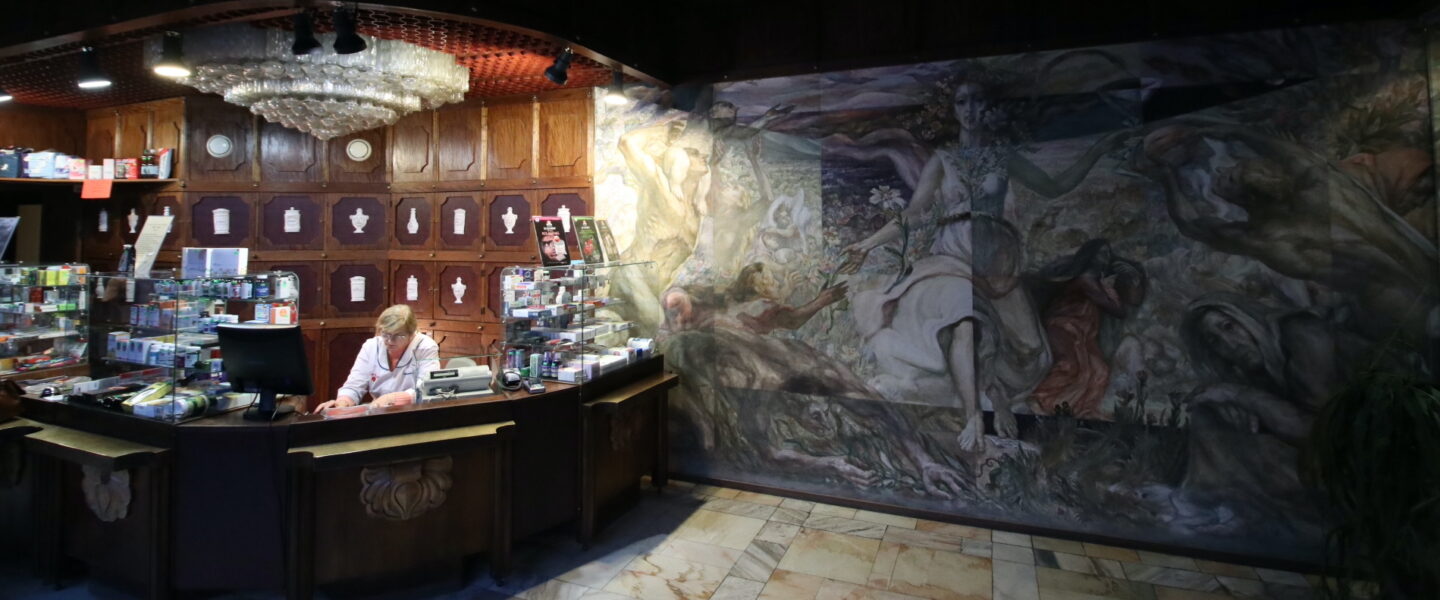
Antanas Kmieliauskas, Hope, 1982. Fresco. Pharmacy Vilties (Hope) in Kaunas. Courtesy of Gregor Taul. Photo from 2020.
EKA, A501
Start Date:
01.07.2024
Start Time:
11:00
End Date:
01.07.2024
On 1 July at 11:00 Gregor Taul will defend his thesis “Monumentality Trouble. Monumental-Decorative Art in Late Soviet Estonia, Latvia and Lithuania” (“Sekeldused monumentaalsusega. Monumentaal-dekoratiivkunst hilisnõukogude Eestis, Lätis ja Leedus”)
The public defence will be held in EKA (Põhja pst 7), room A501.
The defense will be broadcast on EKA TV.
The defence is in English.
Supervisor: Dr. Anu Allas (Estonian Academy of Arts)
External reviewers: Dr. Lolita Jablonskienė (Vilnius Academy of Arts), Dr. Liisa Kaljula (Art Museum of Estonia)
Opponent: Dr. Lolita Jablonskienė
The thesis examines the theme of public art in late Soviet Estonia, Latvia and Lithuania. From its early days, the Soviet Union considered monumental art to be an important part of its ideological propaganda and, more broadly, of the modernisation of society. The concept of monumental-decorative art became commonplace in the Thaw era when Nikita Khrushchev deplored the excesses of Stalinist neoclassical architecture and paved the way for the construction of industrially produced apartment buildings. In the process of mechanising the construction of micro-neighbourhoods, Soviet urban planners and architects developed a methodology for synthesising the arts in new neighbourhoods: standard-design apartment buildings created a backdrop against which public buildings of more unique architecture stood out. These landmark buildings were embellished by a synthesis of the arts in the form of monumental-decorative art – using mural painting, ceramics, textiles, stained glass and metalwork.
To a certain extent, monumental decorative art embodied the authoritarian position of state power, linked to top officials who had the power to semioticise reality. On the other hand, monumental decorative art also offered artists the opportunity to distance themselves from ideological messages and focus on aesthetic and architectural details. Several were associated with the more critical practitioners of the art field, and some artists succeeded in conveying messages directly critical of power in their monumental works. In most cases, however, it was commissioning officials who succeeded in freeing art from direct ideological demands and giving artists access to the wide range of possibilities offered by monumental art. Thus, monumental-decorative art is an interesting phenomenon against the background of which to discuss the blurred boundaries between the official politics of the late Soviets and a somewhat transgressive artistic culture.
In the thesis, the author discusses how monumental-decorative art contributed to the creation of a period-specific socialist spatial atmosphere. To what extent did this aesthetic phenomenon express the ideals and realities of socialism? What visual and spatial aspirations did artists invest in this monumental urge? The thesis concludes that the Baltic artists’ contacts with the rest of the Soviet Union were stronger than previously thought. In addition to opening up the institutional background, the dissertation speaks about the artists’ choices and individual practices of adaptation during the Soviet period. The final chapter of the thesis focuses on the question of the agency of works of art in their valorisation and preservation. Taul seeks answers to the questions of what aspects have contributed to the preservation and conservation of Soviet-era public artworks, what is the meaning of this heritage, and how do these works contribute to making sense of the Soviet period in the Baltic States.
The thesis is available HERE.
Defence Committee: Prof. Andres Kurg (Head of the Committee), Prof. Virve Sarapik, Dr. Anneli Randla, Prof. Krista Kodres, Prof. Marek Tamm, Prof. Eneken Laanes
